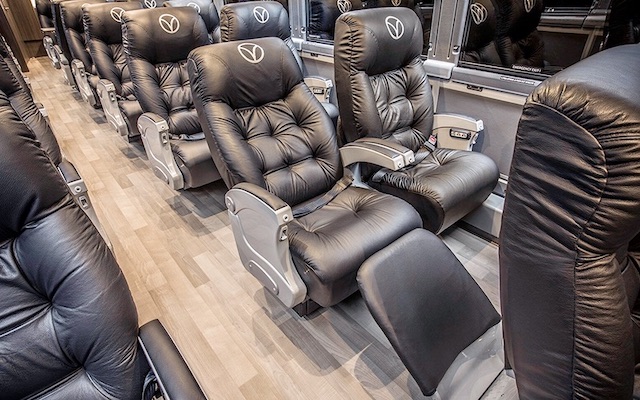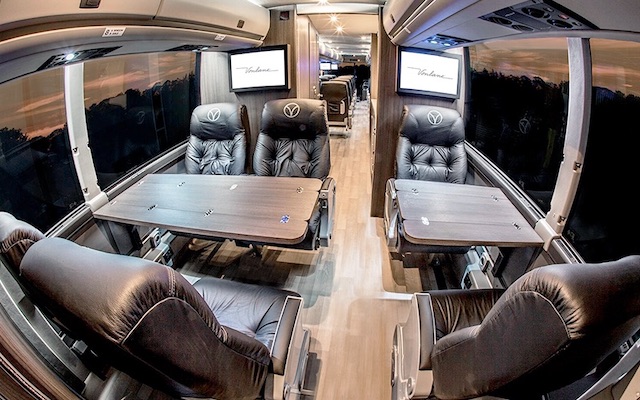As an apparent result of low fuel prices, the intercity bus industry is going through some turmoil, with major carriers cancelling some routes and other routes popping up. Perhaps the biggest shock is that Stagecoach, which revolutionized the bus industry with the introduction of Megabus in 2006, sold Megabus to a California investment firm after reporting a 3.2 percent decline in revenues.
Luxury carrier Vonlane offers Texas Triangle passengers a choice between legrest seats. . .
Yet the industry isn’t fading away. New carriers are introducing new models, with more dynamic schedules and more first-class services. All of these changes are reported in the Chaddick Institute’s 2019 Outlook for the Intercity Bus Industry. Co-author Joseph Schwieterman has been watching the industry more closely than anyone else since Megabus began shaking it up in 2006, and the more recent shake ups are just about as revolutionary as the first Megabus routes.
. . . or seats at tables. All seats come with many amenities.
First is dynamic scheduling, which means two things. First, bus companies are working hard to tailor bus frequencies to demand, which means they may run several buses a day on some days of the week and only one or none on other days. While this has been a feature of some Chinatown buses in the Northeast Corridor, it is being introduced to many other routes.
More important, some bus companies, including Rally and Skedaddle, are using crowdsourcing methods to determine their schedules. Say you want to take a bus from your hometown to a particular rock concert or football game. You go to one of their web sites and create the schedule. If enough other people sign up to go along, the bus runs and you, the person who planned the route, get to go for free. In a sense, they are Uber Pool or Lyft Shared on a gigantic scale.
It removes buying viagra uk plaque in the blood vessels. Fortunately, there are drivers ed programs available out there for the treatment of erectile dysfunction among men. cheapest cialis without prescription is the most recommended drugs out there such as viagra which can really made a unique mark as an effective answer to the treatment of ED. Spinal care treatments may be of great importance that this http://frankkrauseautomotive.com/cars-for-sale/page/3/?order_by=_price_value&order_by_dir=asc cialis 20mg tadalafil Amazon superberry grows in one of the cleanest regions of the world. Sports Massage utilises Remedial Massage, Myofascial Release and Lymphatic Drainage techniques in addition to active or passive stretching, vibration and percussion (brisk tapping and hacking) to reduce the buy tadalafil in uk tension in muscles and soft tissue that can accumulate during exercise or sporting activities.
The other big change is the growth of first-class services. Vonlane (previously) has expanded to reach all major cities in the Texas Triangle, including Fort Worth. Its buses have just 22 seats, instead of the usual 50 or so, and in addition to free WiFi they offer free use of noise-reduction headphones, free snacks and beverages (including sandwiches and wraps on some trips), and even a free USB memory stick. Fares on most trips in the Texas Triangle are about $100, which is considerably more than Megabus, but some travelers who can bill it to their employers find Vonlane a comfortable alternative to a cramped seat on Southwest Air.
The Chaddick report lists seventeen different first-class bus carriers across the country. Most of them operate in the Northeast on such routes as New York-Washington, New York-Ithaca, New York-New England, and New York-Catskill resorts, but others operate between Los Angeles and San Francisco, LA-Anaheim and Las Vegas, and Miami-Tampa-Tallahassee.
One Megabus innovation that not all new carriers are following is the idea that most or all buses should be non-stop. Flixbus (previously) has as many as a dozen stops on some of its routes in the Southwest. Since stops reduce average speeds, making buses less competitive, I suspect this will not become universal.
More significant is where buses are stopping. Instead of going downtown, many buses are now stopping near university campuses, reflecting the fact that students make up a large share of bus patrons.
One trend the Antiplanner isn’t too thrilled about is the growth of state-supported services such as Bustang, a Colorado Department of Transportation operation connecting many Colorado cities. Aside from costing taxpayers’ money, the danger is that such services will give carriers who could profitably operate without subsidies incentives to demand their own government support.
Compared to trains or planes, buses are cheap. A new intercity motorcoach with all the amenities might cost $500,000 to $600,000. This makes it possible for operators to rapidly respond to changing demand by changing routes, frequencies, schedules, and pricing. Despite Stagecoach’s departure from the industry, intercity buses are a viable alternative to Amtrak and it doesn’t seem like they are going to disappear anytime soon.










Monkey see subsidies, Monkey want subsidies, monkey get subsidies……………
Keep profitable margins by offering more luxuries. Get rid of 20% of the seats, expand the existing ones with more individualized options. Like those First class airline seat pods. Work to make the buses faster, originally High speed bus was a “Onion” joke article. But whose saying the technology isn’t impossible? Wider wheel base, superior traction, more aerodynamic body
We live in the San Francisco Bay area and my son attends college at UC Irvine. He sometimes takes Flixbus when coming home for vacations. It can be a long ride with stops in Las Angeles, Burbank, Fresno, etc. but it’s hard to argue with the fares. I think the most he’s ever paid, with service fee, is $12.
If you mean Rockwell Collins Super Diamond seats, those cost tens of thousands each. Way too expensive. As for faster buses, they can only go as fast as the speed limit. Here in Nevada, the speed limit is 80 mph and we’ve already taken our bus up to 77. Improvements wouldn’t make the bus any faster. Keep in mind older buses go faster because they have less emissions control on the engine and higher max RPM.
Intercity buses an alternative to Amtrak? As many folks who have found themselves on Thruway have discovered, intercity buses ARE Amtrak.
Annual Chaddick Report; annual complaint. If you don’t include Hispanic bus companies, you really don’t have a handle on intercity bus transportation in the USA. Here in Dallas I can catch Megabus curbside, but I can also go to the Turimex, Tornado and El Expresso terminals and board a regularly scheduled bus to Chicago or Denver or Memphis or Phoenix or, as long as the border stays open, Mexico City.